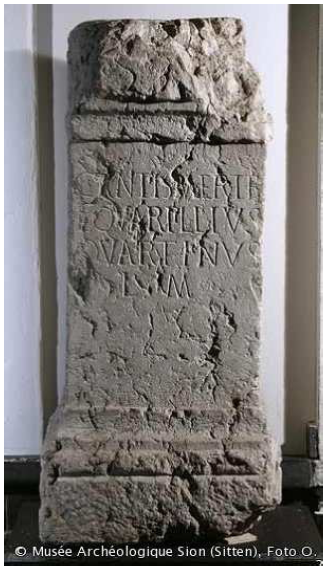C) Cantismerta
The goddess Cantismerta is mentioned in a single inscription discovered in 1858 in Lens (Switzerland), near the Chapelle Saint-Clément: Cantismerte L(ucius) Quartillius Quartinus [v(otum) s(olvit)] l(ibens) m(erito), ‘To the goddess Cantismerta, Lucius Quartillius Quartinus paid his vow willingly and deservedly’ (fig. 26).828 Her name might be found again in a graffiti engraved on a pottery bowl discovered during excavations carried out in the new cemetery of Vannes (Morbihan) in 1899-1900. The graffiti being very difficult to read, its significance remains uncertain and hypothetical. Lambert proposes two possible readings: C]antismertis srl or ]I Atesmertisrl.829

Her name is composed of smertā, ‘distribution’ and of a prefix canti-, the significance of which has still not been determined with certainty. The translation proposed by Jean-Jacques Hatt of canti-, ‘white’ and Cantismerta, ‘Purveyor of Whiteness’ is improbable.830 This etymology* put him on the wrong track. He supposed that Cantismerta was the primary goddess lying behind the goddess Candida Regina, who was honoured in two damaged steles* combining images and inscriptions found in Ingwiller (Alsace) – destroyed in 1870. The first one was engraved above the depiction of a man and a woman standing in a niche: D(e)ae Can[…] Reginae Io[…] c[…] a[…] ex [v]oto p(osuit) l(ibens) l(aet…) m(erito), ‘To the goddess Can(?) Regina Io(?) (offered this) in accomplishment of a vow’ (fig. 27).831 The second one was engraved above the relief* of three personages standing in a niche: D(eae) C(an…) R(eginae) Divixta Terentiani (filia) v(otum) s(olvit), ‘To the Goddes Can(?) Regina Divixta, daughter of Terentianus paid her vow willingly and deservedly’ (fig. 27).832 The dedicator Divixta is a woman peregrine* who bears a typical Celtic name, based on the root divic-, ‘to avenge, to punish’.833 At first, Hatt thought he could reconstruct the name Cantismerta from the damaged altar, but he later acknowledged that this reconstitution was inaccurate.834 There is clearly not enough space between Can[…] and Regina for nine other letters. The discovery of an inscription dedicated to the goddess Candida Regina in Heddernheim (Germany) in 1965 allowed him to restore the name of the goddess honoured in steles* from Ingwiller: Candida.835 He believed Candida could have replaced Cantismerta, because Candida and Cantismerta both had names referring to ‘brightness’, but this theory is not admissible on account of the inaccuracy of his suggested etymology*.

As far as Schmidt and Lejeune are concerned, they suggest relating canti- to a Celtic canto- meaning ‘wheel’. Cantismerta would thus be a ‘Purveyor having the wheel for emblem’.836 In view of this etymology*, Hatt suggests that Cantismerta could be the divine warrrioress represented on a coin of the Ambiani riding two horses and holding a torque* in her right hand and a wheel in her left hand (Chapter 3, fig. 13).837 However, when comparing this coin with others of the same style, the round object brandished by the female rider is clearly not a wheel but a shield.838 As for Evans, he relates canti- to *canto-, ‘hundred’,839 which leads Olmsted to gloss Cantismerta as ‘With Hundred Foresight’.840 Finally, Lambert and Delamarre argue convincingly that canti- should be understood as a preposition *kanta/kanti meaning ‘with’.841 Cantismerta would thus be a ‘Great Purveyor’ like Rosmerta and Atesmerta, but her name has a slight difference in meaning. Lambert explains that Rosmerta embodies “the achieved and definitive distribution”, while Cantismerta symbolises “the general and continuous distribution in space and time”.842